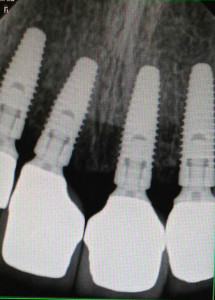Patients come in every week needing replacement of their front teeth. This is one of the most important and challenging aspects of implant dentistry. Almost anyone can place an implant and put a crown on top, but the challenge is to make it look natural and esthetic. While there is much artistry in surgery, hard science is the foundation.
What does the hard science say about a common situation implant surgeons run into? Here’s the problem. When replacing a tooth with an implant, there is almost always a small gap of empty space left around the implant near the coronal part. What should be done with that space?
There are two options:
- Do nothing and let a clot fill in.
- Fill in with bone grafting material (many different types of grafting materials)
A recent study by Novaes, et al (Journal of Oral Implantology, 38:6) from Brazil looked at this problem in the animal model. They extracted teeth, placed implants and then had two different groups of animals: In one they placed nothing and in the second they placed a synthetic bone graft.
Their results showed that there was no statistically significant difference between the two groups. While this may sound counterintuitive; how can no bone graft grow bone? The answer lies in the special qualities of an extraction socket and the conservative surgical procedure utilizing a minimally invasive technique.
Keeping up with the latest developments in the research field of implant surgery is critical for anyone placing implants. Well designed studies can change the way we practice and improve the results for our patients.

